Households Behaviour towards Sustainable Energy Management in Poland—The Homo Energeticus Concept as a New Behaviour Pattern in Sustainable Economics
Abstract
1. Introduction
- preservation of present and future generations,
- inter- and intra-generational equity,
- reduction of climate changes and natural degradation,
- quality improvement of the natural environment,
- and rational management of energy, resources and energy efficiency.
2. Materials and Methods
2.1. Literature Review of Homo Concepts in Economics
2.2. Methodology of the Survey
2.3. Methodology of Behavioural Model Construction
- a long-term approach to planning and decision-making, with full observance of social interests and benefits, even at the cost of additional financial expenses,
- collective approach to decision-making processes (strongly influenced by external stimuli), relevant to their immediate settings,
- propensity to cooperate,
- distinct inclusion of elements of immaterial motivation in their decision-making processes,
- motivation by external stimuli accompanied by internal motivation stimuli,
- full recognition of interests of future generations, highly emotional attitude towards the natural environment,
- responsibility for environmental sustenance in practical realisations of economic decisions,
- strong preference for environmental protection factors as fundaments of their consumer choices.
- provisional, short-term approach to planning and decision-making,
- the individualised approach to economic decisions, independent from external influence,
- placing own economic benefits before other concerns of social/communal interest, such as preservation of the natural environment,
- distinct preference for economic factors as fundaments of choices made concerning energy consumption and/or production: pricing, profitability, earnings, subsidisation, funding, investment payback period.
3. Results
3.1. The Number of Homo Energticus Households
3.2. Demographics
3.3. Survey Responses from the Homo Energeticus Segment
3.4. Statistical Differences between Behaviours Displayed by Homo Energeticus and Those Observed in the Remaining Household Segments
3.5. Properties Displayed by the Homo Energeticus Segment
4. Discussion
4.1. Research Limitations
4.1.1. Social Bias Participation
- Pilot studies were conducted before the target study to allow corrections and modifications to the survey questionnaire. In addition, the survey structure, length and logic were checked. As a result, many questions were shorted and simplified.
- The author of the article conducted a series of training addressed to the interviewing team. She explained the crucial definitions f.e., RES, and showed how to gather data well in accordance with the study’s main goal.
- The PAPI questionnaires that the interviewers completed during the interview contained detailed instructions to:
- (a)
- do not suggest answers to questions, especially in closed-ended questions,
- (b)
- do not press for a specific answer.
- At the end of the interview, the interviewer filled out a special questionnaire where he answered two questions:“Was any other adult present in addition to the respondent during the interview?” and “Did the presence of this person influence the answers given by the respondent?”. He also defined the attitude of the respondent to the interview as:
- (a)
- definitely kind,
- (b)
- rather kind,
- (c)
- inert,
- (d)
- rather reluctant,
- (e)
- definitely reluctant.
- The interviewer was obliged to fill the appendix and note the number of respondents from the path with whom the interview was not possible. He also had to state the reason why the interview was not conducted.
- The interviewer filled in and signed a declaration that he had started the interview at the address indicated and conducted the interview in person.
- Professional company with a long-standing reputation on the market was responsible for the survey conduction.
- The rule of “breaking down” complex concepts was introduced. It offered better clarity to the respondents. Homo concept statements were broken down into multiple connected questions and placed among the other questions in the questionnaire (questionnaire consisted of 33 and 6 demographics questions).
- To avoid suggestion of the “proper” answers one should provide and skew the results toward “homo sustinens” rather than “homo oeconomicus”, the statements concerning the two concepts of homo were presented in random order.
- Interval scale questions were introduced to help get more accurate and effective answers. For example, the homo statements could be answered by provide following options: “I definitively agree”, “I rather agree”, “I definitively disagree”, “I rather disagree”.
- In some statements concerning homo oeconomicus once the negative responses received highest scores, once the positive ones. This helped to avoid “proper” answers one should provide.
- To increase the credibility of collected findings, several verifying queries were included, containing alternative wordings of questions already posed in other questionnaire sections. In this manner, accordance between such related items served to confirm the authenticity of declared behaviour, thus limiting the emergence of purely declarative statements in some of the studied aspects.
4.1.2. Critical Percentage Threshold
4.2. Future Research
- hybrid solutions combining various RES technologies (photovoltaic panels, solar collectors, heat pumps for heating and cooling, energy storage, including those integrated with EV, PHEV),
- the forms of active energy consumers (virtual prosumers, individual prosumers, citizen energy communities, energy clusters, energy cooperatives).
5. Conclusions
- Consideration for the needs of present and future generations.
- Consideration for the natural environment and willingness to take responsibility for its condition, irrespective of general opinions on the matter.
- Emphasis on the use of locally available resources (including the introduction of RES) and the improvement of energy supply security on a local level.
- Awareness of the positive pro-environmental effects of RES solutions.
- Intention to increase the energy efficiency and reliability of energy supply.
- Confidence in improvements in breathable air quality and energy supply security/reliability.
- Attitude of cooperation and co-action, with a collective approach to decision-making procedures.
- Cooperation on common goals and the ability to place social interest before own profit.
Funding
Institutional Review Board Statement
Informed Consent Statement
Data Availability Statement
Conflicts of Interest
References
- Burns, T.R. The sustainability revolution: A societal paradigm shift? Sustainability 2012, 4, 1127–1128. [Google Scholar] [CrossRef]
- The European Green Deal. Communication from the Commission to the European Parliament, the European Council, the Council, the European Economic and Social Committee and the Committee of the Regions. European Commission, Brussels, 11.12.2019 COM(2019) 640 Final. Available online: https://eur-lex.europa.eu/legal-content/EN/TXT/?qid=1588580774040&uri=CELEX%3A52019DC0640 (accessed on 26 May 2021).
- The European Climate Pact: Empowering Citizens to Shape a Greener Europe, European Commission. Available online: https://ec.europa.eu/commission/presscorner/detail/en/ip_20_2323 (accessed on 13 February 2021).
- Powering a Climate-Neutral Economy: An EU Strategy for Energy System Integration, European Commission, Brussels, 8.7.2020 COM(2020) 299 Final. Available online: https://eur-lex.europa.eu/legal-content/EN/TXT/PDF/?uri=CELEX:52020DC0299&from=EN (accessed on 21 February 2021).
- Proposal for a Regulation of the European Parliament and of the Council Establishing the Framework for Achieving Climate Neutrality and Amending Regulation (EU) 2018/1999 (European Climate Law) Brussels, 4.3.2020 COM(2020) 80 Final 2020/0036 (COD). Available online: https://eur-lex.europa.eu/legal-content/EN/TXT/?uri=CELEX:52020PC0080 (accessed on 6 April 2021).
- Directive (EU) 2018/2002 of the European Parliament and of the Council of 11 December 2018 Amending Directive 2012/27/EU on Energy Efficiency, L 328/210 EN Official Journal of the European Union 21.12.2018. Available online: https://eur-lex.europa.eu/legal-content/EN/TXT/PDF/?uri=CELEX:32018L2002&from=EN (accessed on 6 April 2021).
- Emissions Gap Report 2020. Executive Summary, United Nation Environment Programme and UNEP DTU Partnership (UDP). 9 December 2020. Nairobi, p. 6. Available online: https://wedocs.unep.org/handle/20.500.11822/34438 (accessed on 6 April 2021).
- State of the Union: Commission Raises Climate Ambition and Proposes 55% Cut in Emissions by 2030. 17 September 2020. Available online: https://ec.europa.eu/commission/presscorner/detail/en/IP_20_1599 (accessed on 19 February 2021).
- National Recovery Plan and Resilience Facility. Project of Funds and Regional Policy. Warsaw 21 April 2021, p. 16. Available online: https://www.gov.pl/web/planodbudowy/czym-jest-kpo2 (accessed on 18 May 2021). (In Polish)
- Lewandowski, P.; Kiełczewska, A.; Ziółkowska, K. Zjawisko Ubóstwa Energetycznego W Polsce, W Tym Ze Szczególnym Uwzględnieniem Zamieszkujących W Domach Jednorodzinnych (The Phenomenon of Energy Poverty in Poland, Including Special Consideration of Residents in Single-Family Houses), BIS Research Report 2/2018. Available online: https://ibs.org.pl/publications/zjawisko-ubostwa-energetycznego-w-polsce-w-tym-ze-szczegolnym-uwzglednieniem-zamieszkujacych-w-domach-jednorodzinnych/ (accessed on 2 March 2021). (In Polish).
- Ebrahimigharehbaghi, S.; Qian, Q.K.; Meijer, F.M.; Visscher, H.J. Unravelling Dutch homeowners’ behaviour towards energy efficiency renovations: What drives and hinders their decision-making? Energy Policy 2019, 129, 546–561. [Google Scholar] [CrossRef]
- Air Quality in Wroclaw. Available online: https://www.iqair.com/poland/lower-silesia/wroclaw (accessed on 3 March 2021).
- Dzikuć, M.; Piwowar, A.; Szufa, S.Z.; Adamczyk, J.; Dzikuć, M. Potential and Scenarios of Variants of Thermo-Modernization of Single-Family Houses: An Example of the Lubuskie Voivodeship. Energies 2021, 14, 191. [Google Scholar] [CrossRef]
- European Environment Agency. Available online: https://www.eea.europa.eu/data-and-maps/figures/relative-reductions-in-the-premature (accessed on 6 April 2021).
- Piwowar, A. Agricultural Biogas—An Important Element in the Circular and Low-Carbon Development in Poland. Energies 2020, 13, 1733. [Google Scholar] [CrossRef]
- Gawlik, L. The Polish power industry in energy transformation process. Miner. Econ. 2018, 31, 229–237. [Google Scholar] [CrossRef]
- Wroclaw Is the Third Fastest Growing City in the EU. Available online: https://constructionmarketexperts.com/en/news/wroclaw-trzecim-najszybciej-rozwijajacym-sie-miastem-w-ue/ (accessed on 21 February 2021).
- Energyregion-Effective Development of Dispersed Renewable Energy in Combination with Conventional Energy in Regions. Central Europe Project, European Regional Development Fund. 11 Partners from Poland, Czech Republic, Slovenia and Germany. The Project Implemented in Lower Silesia Region. Available online: http://www.umwd.dolnyslask.pl/gospodarka/projekty-w-ramach-europejskiej-wspolpracy-terytorialnej/projekty-zakonczone/energyregion/ (accessed on 21 February 2021).
- Steg, L.; Vlek, C. Encouraging pro-environmental behaviour: An integrative review and research agenda. J. Environ. Psychol. 2009, 29, 309–317. [Google Scholar] [CrossRef]
- Abrahamse, W.; Steg, L.; Vlek, C.; Rothengatter, T. A review of intervention studies aimed at household energy conservation. J. Environ. Psychol. 2005, 25, 273–291. [Google Scholar] [CrossRef]
- Kormos, C.; Gifford, R. The validity of self-report measures of proenvironmental behavior: A meta-analytic review. J. Environ. Psychol. 2014, 40, 359–371. [Google Scholar] [CrossRef]
- Barr, S. Factors Influencing Environmental Attitudes and Behaviors: A U.K. Case Study of Household Waste Management. Environ. Behav. 2007, 39, 435–473. [Google Scholar] [CrossRef]
- Nolan, J.M.; Schultz, P.W. Prosocial behavior and environmental action. In The Oxford Handbook of Prosocial Behavior; Schroeder, D.A., Graziano, W.G., Eds.; Oxford University Press: Oxford, UK, 2015; pp. 626–652. [Google Scholar]
- Meyer, A. Does education increase pro-environmental behavior? Evidence from Europe. Ecol. Econ. 2015, 116, 108–121. [Google Scholar] [CrossRef]
- Stieß, I.; Dunkelberg, E. Objectives, barriers and occasions for energy efficient refurbishment by private homeowners. J. Clean. Prod. 2013, 48, 250–259. [Google Scholar] [CrossRef]
- Murphy, L.C.; Meijer, F.; Visscher, H. A qualitative evaluation of policy instruments used to improve energy performance of existing private dwellings in the Netherlands. Environ. Pol. 2012, 45, 459–468. [Google Scholar] [CrossRef]
- Murphy, L. The policy instruments of European front-runners: Effective for saving energy in existing dwellings? Energy Effic. 2014, 7, 285–301. [Google Scholar] [CrossRef]
- Fawcett, T.; Killip, G.; Janda, K.B. Building expertise: Identifying policy gaps and new ideas in housing eco-renovation in the UK and France. In Proceedings of the European Council for an Energy Efficient Economy, Summer Study, Belambra Les Criques, France, 3–8 June 2013. [Google Scholar]
- Filippidou, F.; Nieboer, N.; Visscher, H. Energy efficiency measures implemented in the Dutch non-profit housing sector. Energy Build. 2016, 132, 107–116. [Google Scholar] [CrossRef]
- Yildiz, Ö.; Rommel, J.; Debor, S.; Holstenkamp, L.; Mey, F.; Müller, J.R.; Radtke, J.; Rognli, J. Renewable energy cooperatives as gatekeepers or facilitators? Recent developments in Germany and a multidisciplinary research agenda. Energy Res. Soc. Sci. 2015, 6, 59–73. [Google Scholar] [CrossRef]
- Yildiz, Ö. Financing renewable energy infrastructures via financial citizen participation. The case of Germany. Renew. Energy 2014, 68, 677–685. [Google Scholar] [CrossRef]
- Rommel, J.; Radtke, J.; Jorck, G.; Mey, F.; Yildiz, Ö. Community renewable energy at a crossroads: A think piece on degrowth, technology, and the democratization of the German energy system. J. Clean. Prod. 2018, 197, 1746–1753. [Google Scholar] [CrossRef]
- Roth, L.; Lowitzsch, J.; Yildiz, Ö.; Hashani, A. Does (Co-)ownership in renewables matter for an electricity consumer’s demand flexibility? Empirical evidence from Germany. Energy Res. Soc. Sci. 2018, 46, 169–182. [Google Scholar] [CrossRef]
- Diefenbacher, H. Gerechtigkeit und Nachhaltigkeit. Zum Verhältnis von Ethik und Ökonomie (Justice and Sustainability. On the Relationship Between Ethics and Economics); Wissenschaftliche Buchgesellschaft: Darmstadt, Germany, 2001. (In German) [Google Scholar]
- Illge, L.; Schwarze, R. A Matter of Opinion—How Ecological and Neoclassical Environmental Economists think about Sustainability and Economics. Ecolog. Econ. 2009, 68, 599–602. [Google Scholar] [CrossRef]
- Siebenhüner, B. Homo Sustinens—Der Mensch für die Zukunft? (Homo Sustinens—A Man for the Future?); Carl von Ossietzky Universität: Oldenburg, Germany, 2005; p. 16. (In German) [Google Scholar]
- Poskrobko, B. Paradygmat zrównoważonego rozwoju jako wiodący kanon w badaniu no wych obszarów ekonomii (The paradigm of sustainable development as a leading canon in the study of new areas of economics). Ekon. Sr. 2013, 3, 19–22. (In Polish) [Google Scholar]
- Słupik, S.; Kos-Łabędowicz, J.; Trzęsiok, J. Energy-Related Behaviour of Consumers from the Silesia Province (Poland)—Towards a Low-Carbon Economy. Energies 2021, 14, 2218. [Google Scholar] [CrossRef]
- Pezzey, J.C.V.; Toman, M.A. Progress and problems in the economics of sustainability. In International Yearbook of Environmental and Resource Economics 2002/2003; Tietenberg, T., Folmer, H., Eds.; Edward Elgar: Cheltenham, UK, 2002. [Google Scholar]
- Graczyk, A.M. Gospodarowanie Odnawialnymi Źródłami Energii W Ekonomii Rozwoju Zrównoważonego. Teoria I Praktyka (Management of Renewable Energy Sources from the Viewpoint of Economics of Sustainable Development. Theory and Practice); Polish Scientific Publisher (PWN): Warsaw, Poland, 2019. (In Polish) [Google Scholar]
- Rogall, H. Ekonomia Zrównoważonego Rozwoju. Teoria I Praktyka (Economics of Sustainable Development. Theory and Practice); Zysk i S-ka: Poznań, Poland, 2010. (In Polish) [Google Scholar]
- Graczyk, A.M. The Formulation of Fundaments and Form of Paradigm of Sustainable Energy. In Proceedings of the 34th International Business Information Management Association Conference, International Business Information Management Association (IBIMA), Madrid, Spain, 13–14 November 2019; pp. 12823–12831. [Google Scholar]
- Blaug, M. Metodologia Ekonomii (Economics Methodology); PWN: Warsaw, Poland, 1995; p. 21. (In Polish) [Google Scholar]
- Smith, A. An Inquiry into the Nature and Causes of the Wealth of Nations; Oxford University Press: Oxford, UK, 1998. [Google Scholar]
- Van Den Bergh, J.C.; Ferrer-i-Carbonell, A.; Munda, G. Alternative models of individual behaviour and implications for environmental policy. Ecolog. Econ. 2000, 32, 49–50. [Google Scholar] [CrossRef]
- Dueck, G. Abschied Vom Homo Oeconomicus—Warum Wir Eine Neue Wirtschaftliche Vernunft Brauchen (Farewell to Homo Oeconomicus—Why We Need a New Economic Sense); Eichborn: Frankfurt, Germany, 2008. (In German) [Google Scholar]
- Lit-Verlag. Vom Homo Oeconomicus zum Homo Culturalis—Handlung und Verhalten in der Ökonomie (From Homo Oeconomicus to Homo Culturalis-Action and Behavior in the Economs); Goldschmidt, N., Nutzinger, H.G., Eds.; Lit-Verlag: Berlin/Münster, Germany, 2009. (In German) [Google Scholar]
- McKenzie, R.B.; Tullock, G. Homo Oeconomicus—Ökonomische Dimensionen des Alltags (Homo Oeconomicus-Economic Dimensions of Everyday Life); Campus: Frankfurt, Germany; New York, NY, USA, 1984. (In German) [Google Scholar]
- Simon, H.A. Models of Bounded Rationality. Empirically Grounded Economic Reason; The MIT Press: London, UK, 1997; p. 293. [Google Scholar]
- Dahrendorf, R. Homo Sociologicus; Routledge & Kegan Paul: London, UK, 1973; p. 58. [Google Scholar]
- Lecouteux, G. From Homo Economicus to Homo Psychologicus: The Paretian Foundations of Behavioural Paternalism. Psych. Econ. Hist. Persp. 2016, 6, 175–200. [Google Scholar]
- Biesecker, A.; Kesting, S. Mikroökonomik: Eine Einführung aus Sozial-Ökologischer Perspektive (Microeconomics: An Introduction from a Socio-Ecological Perspective); Verlag München Wien: Oldenbourg, Germany, 2003. (In German) [Google Scholar]
- Faber, M.; Manstetten, R.; Petersen, T. Homo Oeconomicus and Homo Politicus. Political Economy, Constitutional Interest and Ecological Interest. Kyklos 1997, 50, 457–483. [Google Scholar] [CrossRef]
- Tomer, J.F. Economic Man vs. Heterodox Men: The Concepts of Human Nature in Schools of Economic Thought. J. Socio Econ. 2001, 30, 281–293. [Google Scholar] [CrossRef]
- Siebenhüner, B. Homo Sustinens—Towards a New Conception of Humans for the Science of Sustainability. Ecol. Econ. 2000, 32, 15–25. [Google Scholar]
- Cohen, J.; Cohen, P.; West, S.G.; Aiken, L.S. Applied Multiple Regression/Correlation Analysis for the Behavioral Sciences; Lawrence Erlbaum Associates Inc.: Hillsdale, NJ, USA, 2003. [Google Scholar]
- SAGE. Handbook of Mixed Methods in Social & Behavioral Research; Tashakkori, A., Teddlie, C., Eds.; SAGE: Thousand Oaks, CA, USA, 2010. [Google Scholar]
- CBOS. Polacy o Przyszłości Energetycznej Kraju (Poles about Energy Future in Their Country); CBOS: Warsaw, Poland, 2016; pp. 8, 18, 19, 27–29. (In Polish) [Google Scholar]
- CBOS Collegium Civitas. Polacy o Oszczędzaniu Energii I Energetyce Obywatelskiej (Poles about Energy Saving and Civic Energy Sector); CBOS Collegium Civitas: Warsaw, Poland, 2016. (In Polish) [Google Scholar]
- Zimmermann, H.J. Fuzzy Sets in Pattern Recognition. In Pattern Recognition Theory and Applications; Devijver, P.A., Kittler, J., Eds.; NATO ASI Series; Springer: Berlin/Heidelberg, Germany, 1987. [Google Scholar]
- Martínez-Miranda, J.; Aldea, A.; Bañares-Alcántara, R. A Social Agent Model to Simulate Human Behaviour. In Proceedings of the 3rd Workshop on Agent Based Simulation, Bologna, Italy, 15–16 July 2002; pp. 18–23. [Google Scholar]
- Ghasem-Aghaee, N.; Ören, T.I. Towards Fuzzy Agents with Dynamic Personality for Human Behaviour Simulation. In Proceedings of the 2003 Summer Computer Simulation Conference, Montreal, PQ, Canada, 20–24 July 2003; pp. 3–10. [Google Scholar]
- Michaud, F. Selecting Behaviours using Fuzzy Logic. In Proceedings of the IEEE International Conference on Fuzzy Systems, Barcelona, Spain, 5 July 1997. [Google Scholar]
- Barnev, S.P. Fuzzy System Approach to Decision-Making Based on Public Opinion: Investigation through questionnaires, stochastic control. In IFAC Stochastic Control Symposium; Budapest Technical University: Budapest, Hungary, 1974. [Google Scholar]
- Huffman, A.H.; van der Werff, B.R.; Henning, J.B.; Watrous-Rodriguez, K. When do recycling attitudes predict recycling? An investigation of self-reported versus observed behavior. J. Environ. Psychol. 2014, 38, 262–270. [Google Scholar] [CrossRef]
- Walczak, D.; Dziawgo, L.; Dziawgo, D.; Buszko, M.; Pawłowski, J.; Żołądkiewicz-Kuzioła, A.; Krupa, D. Attitudes and Behaviors Regarding Environmental Protection in the Financial Decisions of Individual Consumers. Energies 2021, 14, 1934. [Google Scholar] [CrossRef]
- Ministry of Climate and Environment. Energy Policy of Poland until 2040; Ministry of Climate and Environment: Warsaw, Poland, 2021. (In Polish)
- Act of 10 April 1997–Energy Law (Journal of Laws of 2020, Item 833, as Amended). Available online: https://isap.sejm.gov.pl/isap.nsf/DocDetails.xsp?id=WDU19970540348 (accessed on 16 May 2021). (In Polish)
- Act of 11 January 2018 on Electromobility and Alternative Fuels (Journal of Laws of 2021, Item 110). Available online: https://isap.sejm.gov.pl/isap.nsf/DocDetails.xsp?id=WDU20180000317 (accessed on 16 May 2021). (In Polish)
- Ministry of State Assets. National Energy and Climate Plan 2021–2030; Ministry of State Assets: Warsaw, Poland, 2020. (In Polish)
- Ministry of Environment. National Policy Framework for Alternative Fuel Infrastructure Development; Ministry of Environment: Warsaw, Poland, 2017. (In Polish)
- The Polish Alternative Fuels Association (PSPA). Available online: https://pspa.com.pl/2021/informacja/licznik-elektromobilnosci-od-stycznia-do-kwietnia-sprzedaz-samochodow-z-napedem-elektrycznym-w-polsce-wzrosla-ponad-dwukrotnie-rok-do-roku/?lang=en (accessed on 16 May 2021).
- Directive (EU) 2019/944 of the European Parliament and of the Council of 5 June 2019 on Common Rules for the Internal Market for Electricity and Amending Directive 2012/27/EU (Text with EEA Relevance.) L 158/140 PL 14.6.2019. Available online: https://eur-lex.europa.eu/legal-content/EN/TXT/?uri=CELEX%3A32019L0944 (accessed on 16 May 2021).
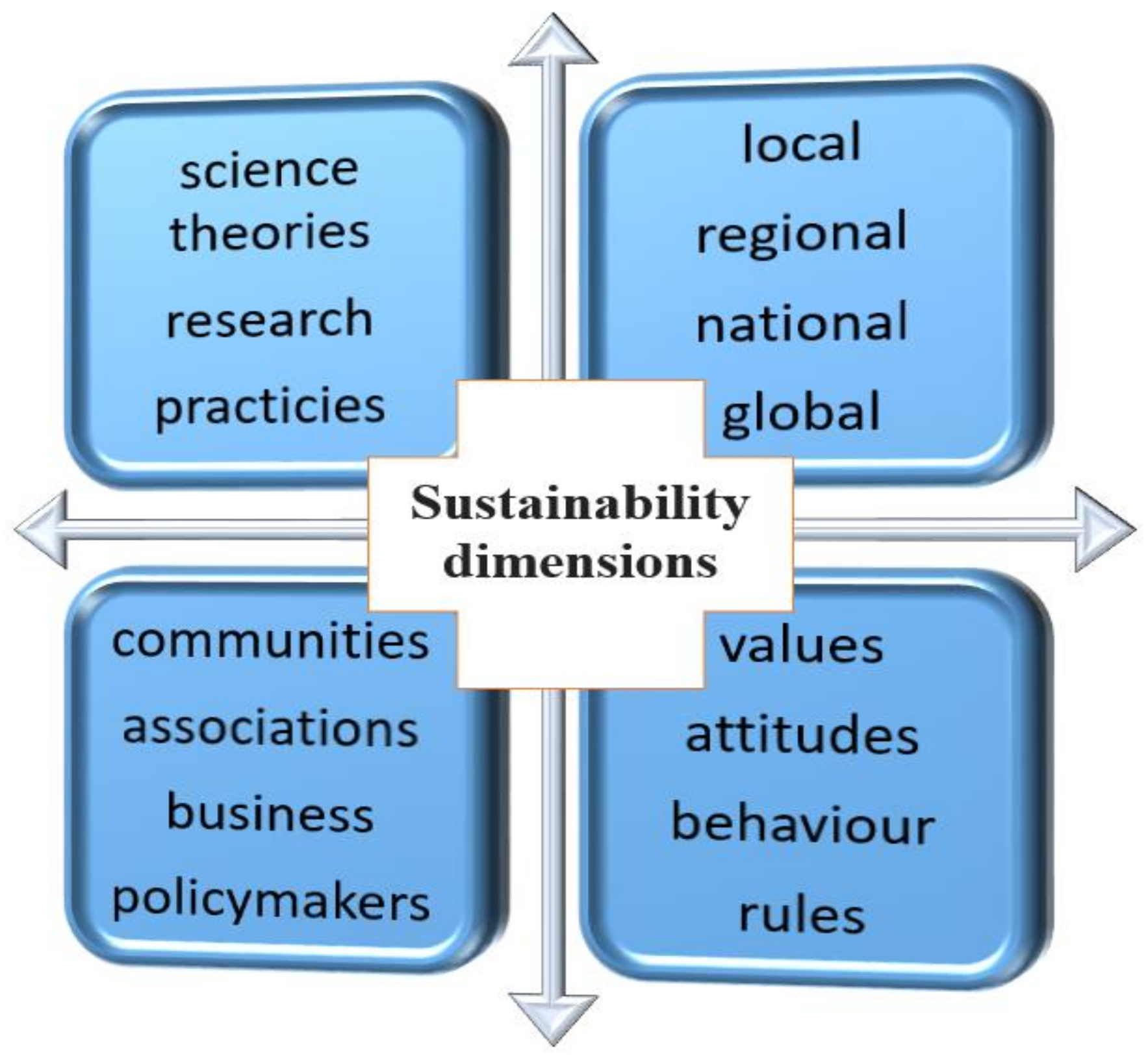

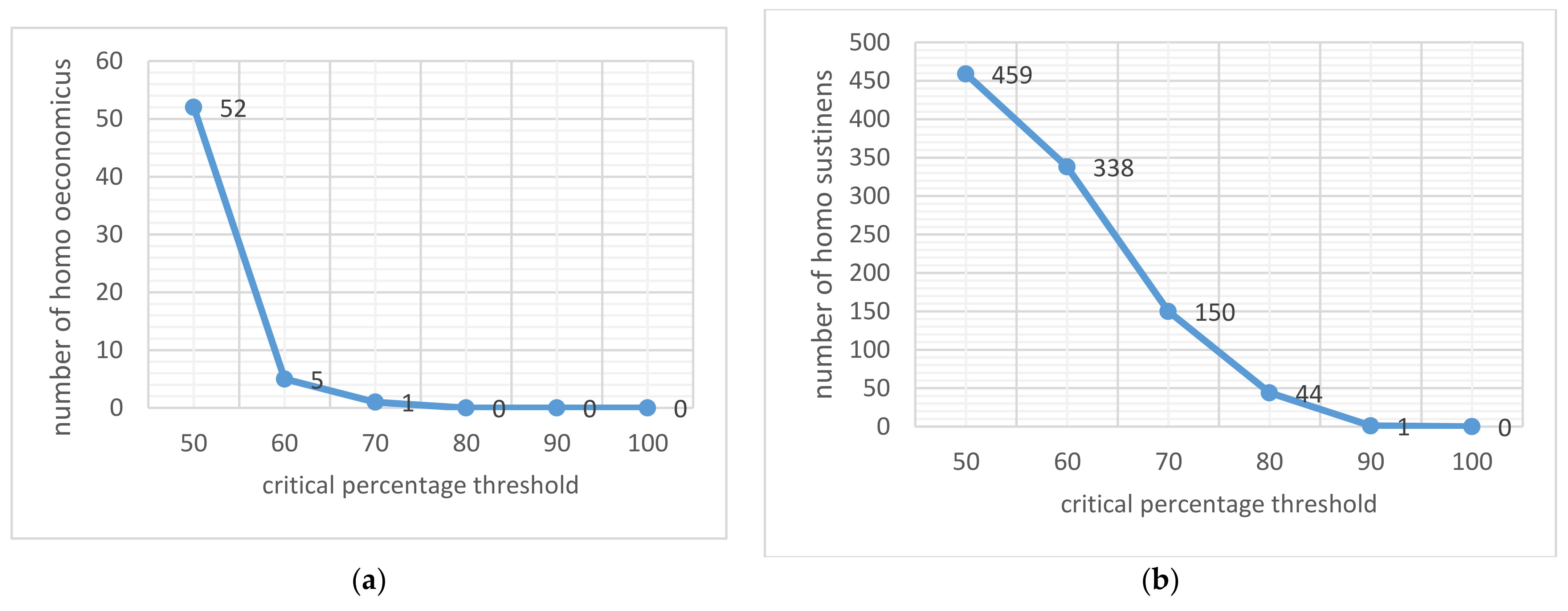
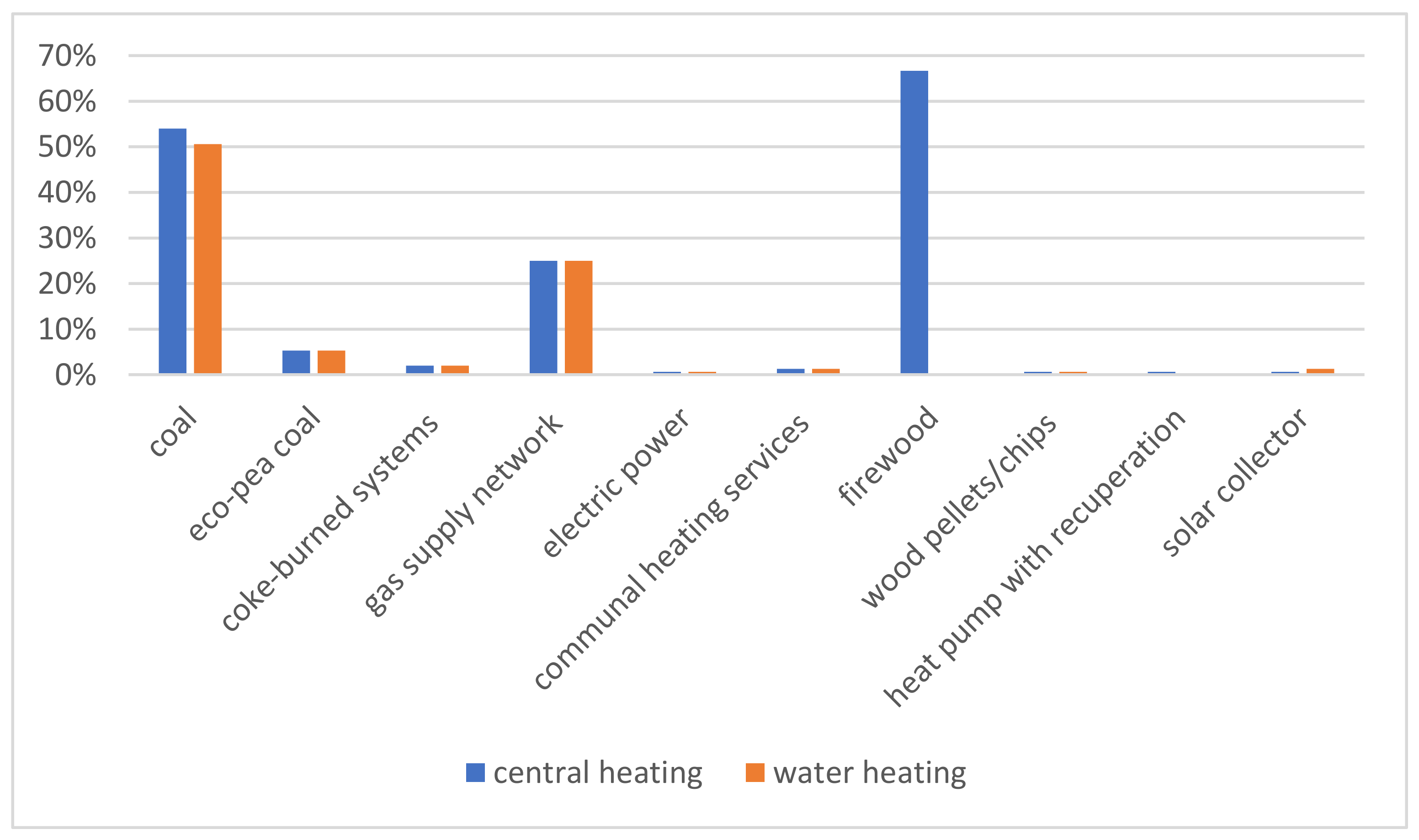
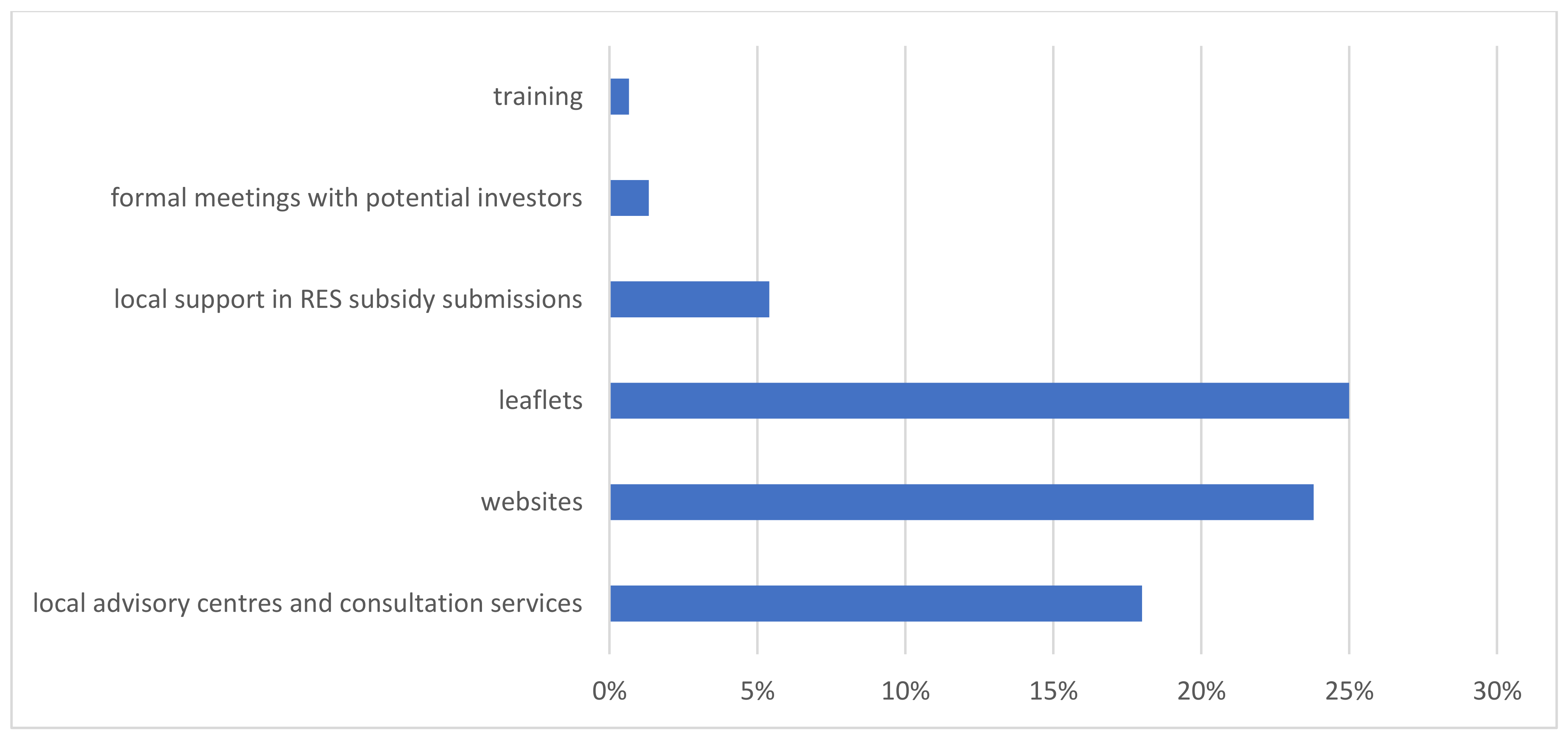
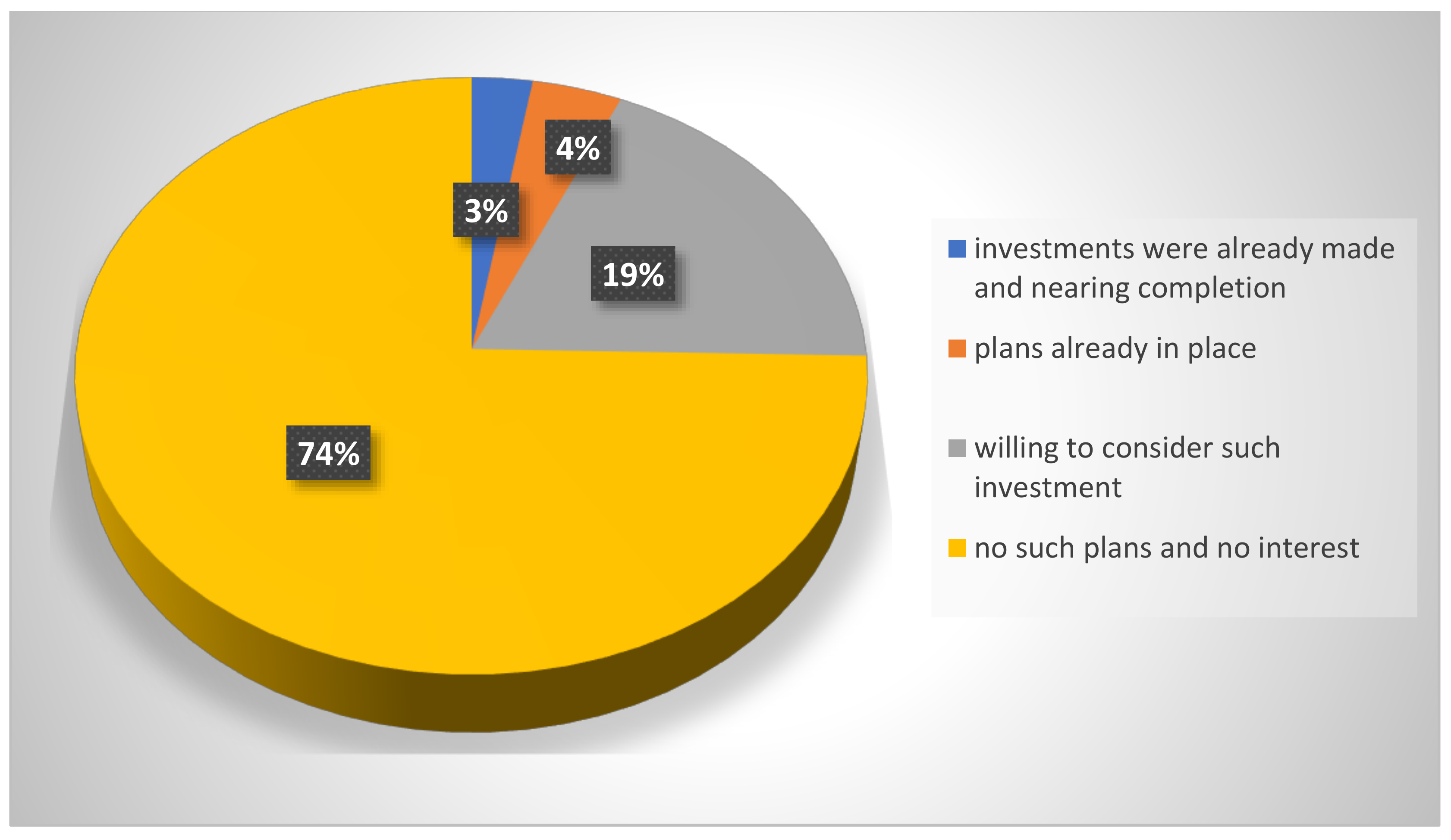
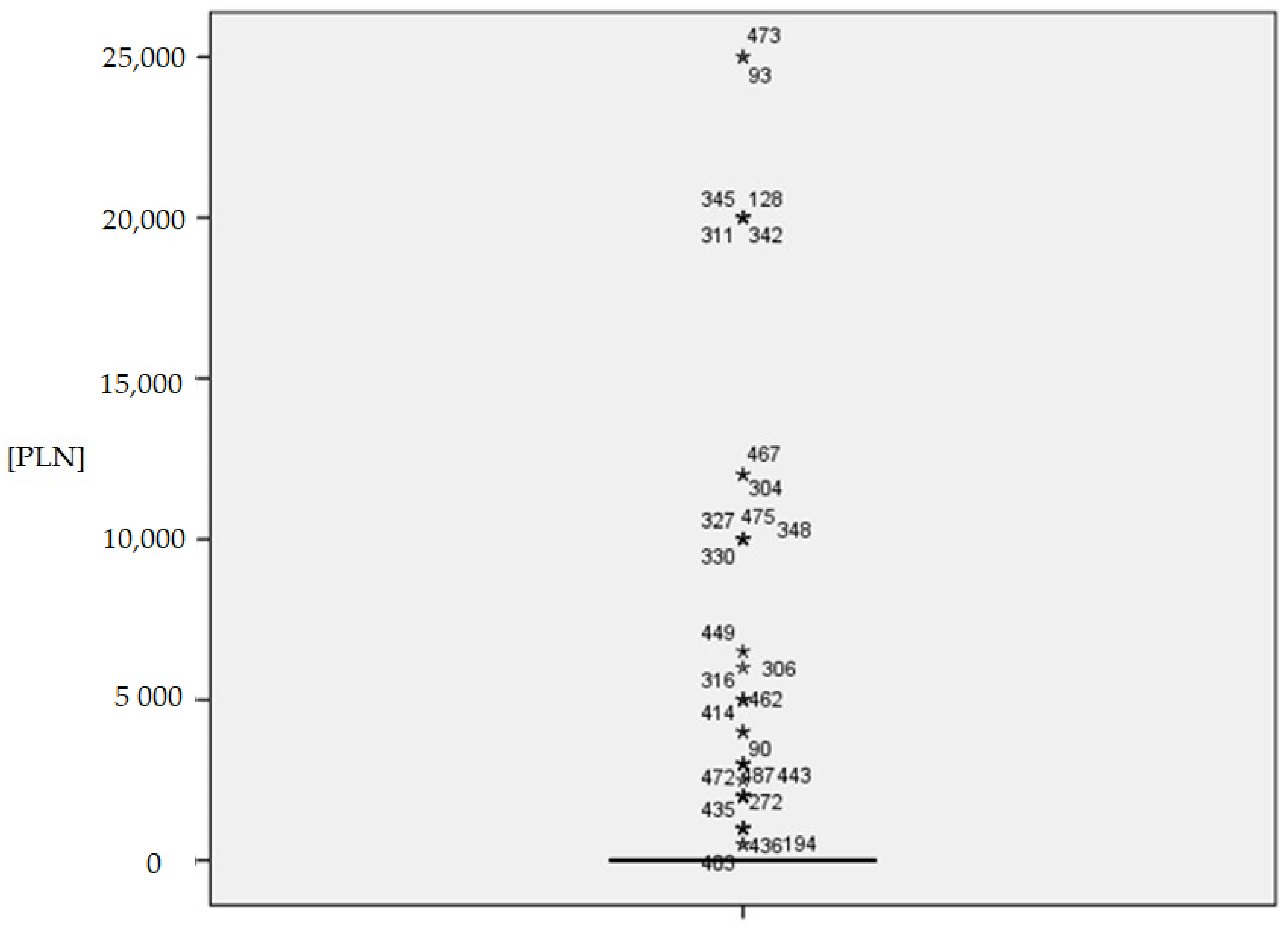
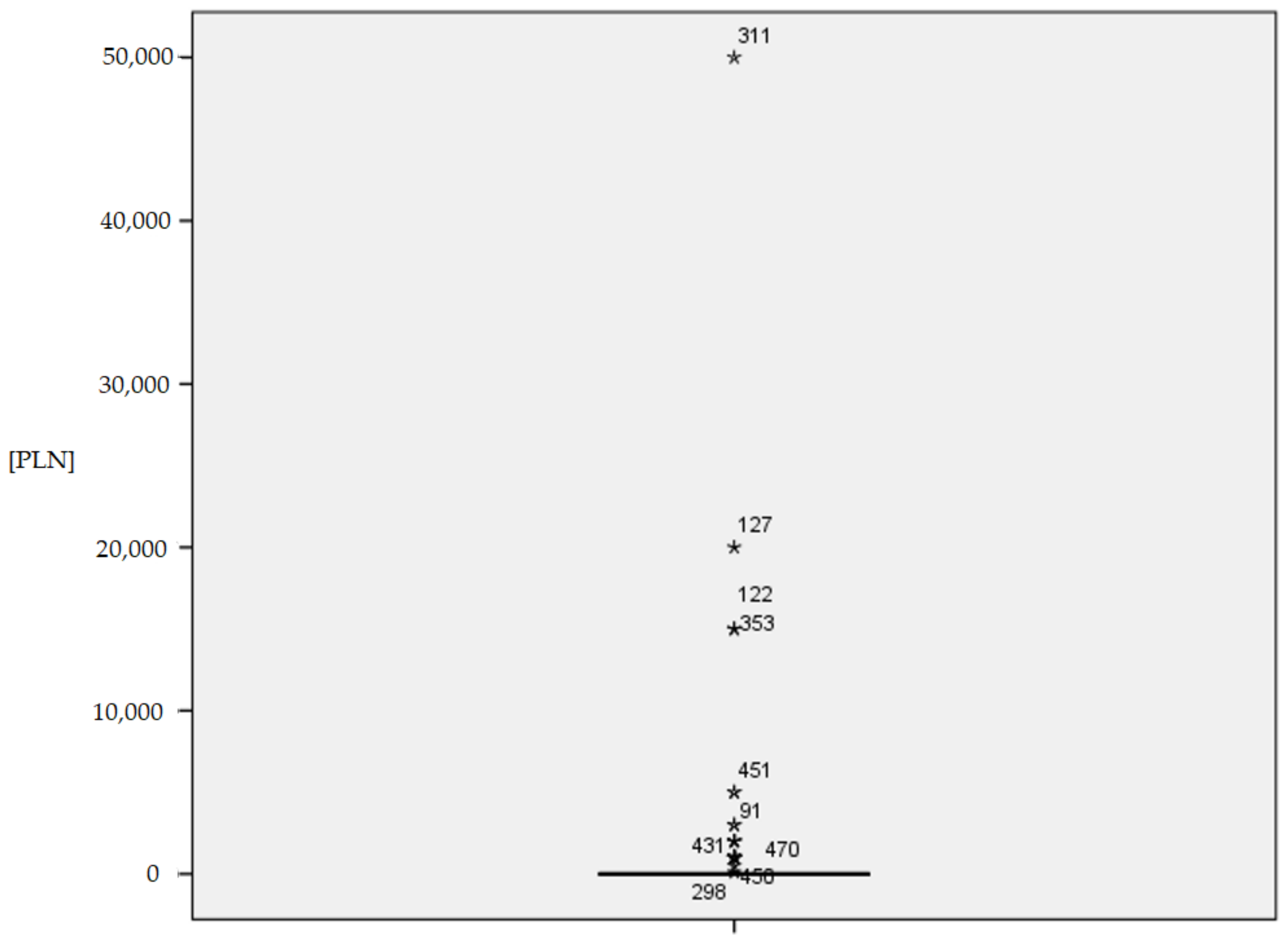
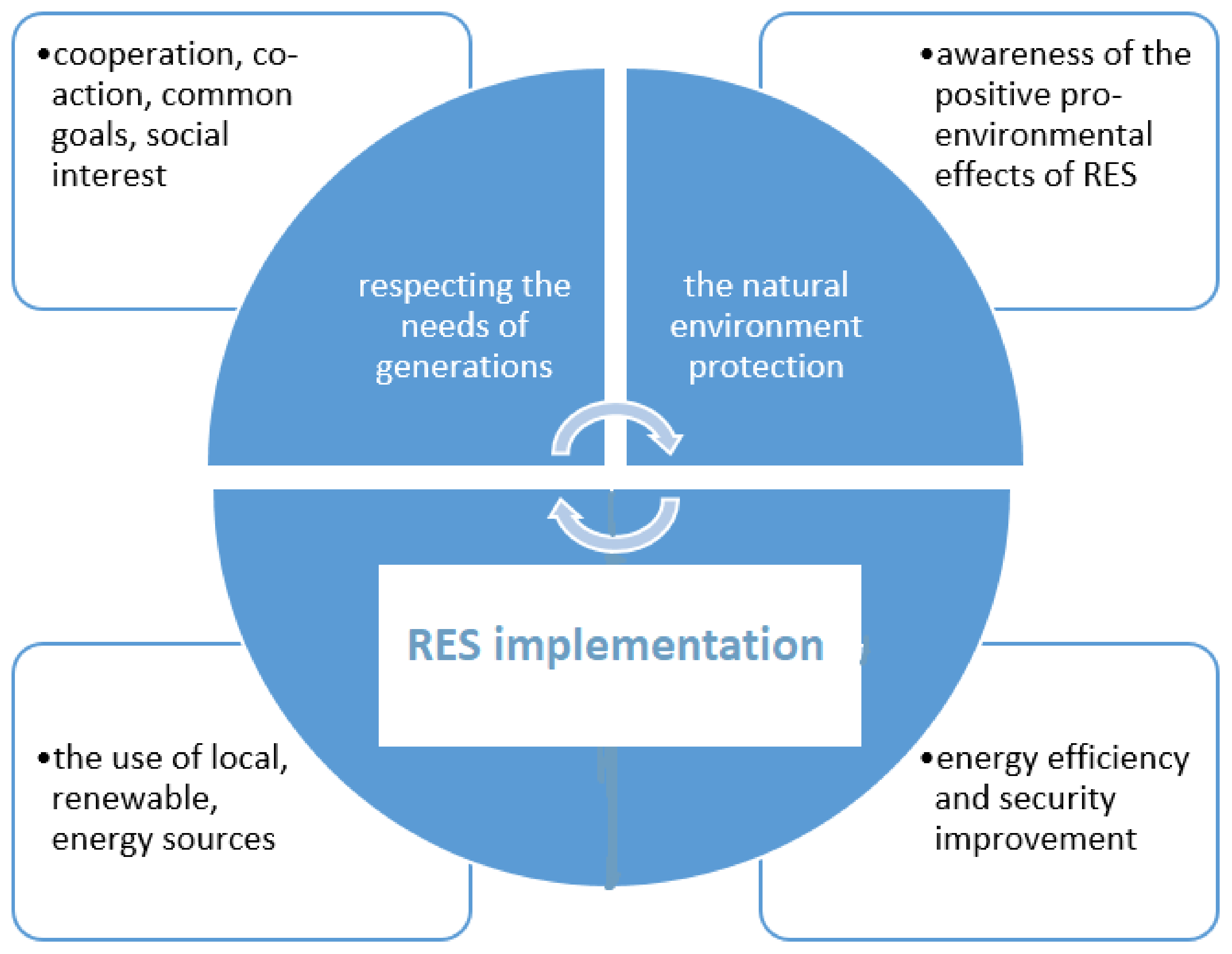
| Territorial Zones | General Population Share | Research Sample | General Population |
|---|---|---|---|
| Lower Silesia region | 100% | 500 | 360,176 |
| Municipal districts | 32% | 161 | 116,016 |
| Rural districts | 34% | 171 | 123,116 |
| Mixed municipal-rural districts | 34% | 168 | 121,044 |
| Statistical Measures | Rate |
|---|---|
| Survey return rate | 100% |
| Maximum admissible error for the estimated fraction (d error) | 4.38% |
| Confidence level (p) | 0.95 |
| Confidence interval (α) | 0.05 |
| Statistical value (z) | 1.96 |
| Points for Responses | Homo Oeconomicus | Homo Sustinens |
|---|---|---|
| Positive responses: “I definitively agree”—4 pts “I rather agree”—3 pts The remaining answers—0 pts: “I definitively disagree”, “I rather disagree” | I prefer economic factors as fundaments of choices made concerning energy consumption and/or production: (a) investment payback period (b) profitability (c) pricing (d) prosumer earnings (e) pricing is more important to me than energy efficiency (f) subsidisation. | I prefer ecological factors as fundaments of choices made concerning energy consumption and/or production: (a) positive RES impact on natural environment (b) enhancing energy efficiency (c) full recognition of interests of future generations, highly emotional attitude towards the natural environment (d) nonfinancial motives. |
| Negative responses (homo oeconomicus only): “I definitively disagree”—4 pts “I rather disagree”—3 pts The remaining answers—0 pts Positive responses (homo sustinens only): “I definitively agree”—4 pts “I rather agree”—3 pts The remaining answers—0 pts | I consider other people’s opinions as fundaments of choices made concerning energy consumption and/or production: (a) family (b) partner/spouse (c) friends/colleagues (d) neighbours. | I consider other people’s opinions as fundaments of choices made concerning energy consumption and/or production: (a) family (b) partner/spouse (c) friends/colleagues (d) neighbours. |
| Positive responses: “I definitively agree”—4 pts “I rather agree”—3 pts The remaining answers—0 pts | (a) I place my economic benefits before others concerns of social/communal interest, such as preservation of natural environment (b) I will invest in fossil fuel sources rather than green ones to get better financial returns (c) I prefer a short-term approach to the planning and decision-making process. | (a) When I invest in RES, I feel that I contribute to air quality improvement (b) I feel responsible for the natural environment condition in my commune/district (c) I do care for future generations to live in a clean natural environment (d) Clean natural environment is a priority in my the decision-making process, benefits and financial costs play less critical role (e) I want to cooperate to make the natural environment cleaner. |
| Positive responses: “I definitively agree”—4 pts “I rather agree”—3 pts The remaining answers—0 pts | I do not care about a clean natural environment | (a) I do care for the natural environment no matter what others think (b) I do care for the natural environment to teach a lesson for others (c) I do care for the natural environment only if others do that. |
| Negative responses (homo oeconomicus only): “I definitively disagree”—4 pts “I rather disagree”—3 pts The remaining answers—0 pts Positive responses (homo sustinens only): “I definitively agree”—4 pts “I rather agree”—3 pts The remaining answers—0 pts | I am willing to pay more for energy consumption bills if the extra cost would serve to support investment in local RES production facilities taken with the purpose of improving the reliability of supply or/and quality of breathable air on a local scale. | I am willing to pay more for energy consumption bills if the extra cost would serve to support investment in local RES production facilities taken with the purpose of improving the reliability of supply or/and quality of breathable air on a local scale. |
| Variable | N | % | |
|---|---|---|---|
| Gender | Women | 90 | 60 |
| Men | 60 | 40 | |
| Level of education | Basic | 8 | 5.3 |
| Vocational-level | 54 | 36 | |
| Secondary | 60 | 40 | |
| Higher | 28 | 18.7 | |
| Age | 18–24 | 3 | 2 |
| 25–34 | 22 | 14.6 | |
| 35–44 | 27 | 18 | |
| 45–54 | 27 | 18 | |
| 55–64 | 39 | 26 | |
| 65 and older | 32 | 21.3 | |
| Place of residence | Municipal areas | 55 | 36.7 |
| Mixed municipal-rural districts | 50 | 33.3 | |
| Rural parishes | 45 | 30 | |
| Type of households | One-person | 7 | 4.7 |
| Two-person | 29 | 19.3 | |
| Three-person | 31 | 20.6 | |
| Four-person | 35 | 23.3 | |
| Five-person | 24 | 16 | |
| Six-person | 13 | 8.7 | |
| Seven-person | 7 | 4.7 | |
| Eight-person | 2 | 1.3 | |
| Nine-person | 1 | 0.7 | |
| Ten-person | 1 | 0.7 | |
| Monthly net household revenue | To 1000 PLN | 12 | 8 |
| 1001–1500 | 25 | 16.7 | |
| 1501–2000 | 27 | 18 | |
| 2001–2500 | 21 | 14 | |
| 2501–3000 | 10 | 6.7 | |
| 3001–4000 | 12 | 8 | |
| 4001–5000 | 5 | 3.3 | |
| 5001–7000 | 6 | 4 | |
| 7001–10,000 | 0 | 0 | |
| More than 10,000 | 2 | 1.3 | |
| Chose not to disclose their revenues | 30 | 20 | |
| Own Expenses for RES Introduction [PLN] | General Population | Homo Energeticus |
|---|---|---|
| 500 | 2 | 0 |
| 1000 | 8 | 1 |
| 2000 | 10 | 6 |
| 2500 | 1 | 1 |
| 3000 | 5 | 3 |
| 4000 | 2 | 0 |
| 5000 | 5 | 1 |
| 6000 | 1 | 1 |
| 6500 | 1 | 1 |
| 10,000 | 6 | 6 |
| 12,000 | 2 | 2 |
| 20,000 | 6 | 3 |
| 25,000 | 2 | 2 |
| I am not willing to invest | 394 | 110 |
| I do not know | 55 | 13 |
| Own Expenses for Gainful Purposes [PLN] | General Population | Homo Energeticus |
|---|---|---|
| 0 | 473 | 0 |
| 100 | 1 | 0 |
| 500 | 1 | 0 |
| 1000 | 11 | 1 |
| 1100 | 1 | 0 |
| 2000 | 5 | 0 |
| 3000 | 2 | 1 |
| 5000 | 2 | 0 |
| 15,000 | 2 | 0 |
| 20,000 | 1 | 3 |
| 50,000 | 1 | 1 |
| The Type of Responses | Homo Energeticus Answers | Number of Responses | Percentages of Responses in the Category |
|---|---|---|---|
| Positive responses: “I definitively agree” “I rather agree” | I prefer ecological factors as fundaments of choices made concerning energy consumption and/or production: | - | - |
| (a) positive RES impact on natural environment | (a) 150 | (a) 100% | |
| (b) enhancing energy efficiency | (b) 149 | (b) 99.3% | |
| (c) full recognition of interests of future generations, highly emotional attitude towards the natural environment | (c) 147 | (c) 98% | |
| (d) nonfinancial motives. | (d) 79 | (d) 52.6% | |
| Positive responses: “I definitively agree” “I rather agree” | I consider other people’s opinions as fundaments of choices made concerning energy consumption and/or production: | - | - |
| (a) family, | (a) 150 | (a) 100% | |
| (b) partner/spouse, | (b) 150 | (b) 100% | |
| (c) friends/colleagues, | (c) 136 | (c) 90.6% | |
| (d) neighbours. | (d) 132 | (d) 88% | |
| Positive responses: “I definitively agree” “I rather agree” | (a) When I invest in RES, I feel that I contribute to air quality improvement | (a) 150 | (a) 100% |
| (b) I feel responsible for natural environment condition in my commune/district | (b) 149 | (b) 99.3% | |
| (c) I do care for future generations to live in a clean natural environment | (c) 150 | (c) 100% | |
| (d) Clean natural environment is a priority in the decision-making process, benefits and financial costs play less critical role | (d) 118 | (d) 78.6% | |
| (e) I want to cooperate to make the natural environment cleaner. | (e) 137 | (e) 91.3% | |
| Positive responses: “I definitively agree” “I rather agree” | (a) I do care for the natural environment no matter what others think. | (a) 147 | (a) 98% |
| (b) I do care for the natural environment to teach a lesson for others. | (b) 149 | (b) 99.3% | |
| (c) I do care for the natural environment only if others do that. | (c) 55 | (c) 36.6% | |
| Positive responses: “I definitively agree” “I rather agree” | I am willing to pay more for energy consumption bills if the extra cost would serve to support investment in local RES production facilities taken with the purpose of improving the reliability of supply or/and quality of breathable air on a local scale. | 12 | 8% |
Publisher’s Note: MDPI stays neutral with regard to jurisdictional claims in published maps and institutional affiliations. |
© 2021 by the author. Licensee MDPI, Basel, Switzerland. This article is an open access article distributed under the terms and conditions of the Creative Commons Attribution (CC BY) license (https://creativecommons.org/licenses/by/4.0/).
Share and Cite
Graczyk, A.M. Households Behaviour towards Sustainable Energy Management in Poland—The Homo Energeticus Concept as a New Behaviour Pattern in Sustainable Economics. Energies 2021, 14, 3142. https://doi.org/10.3390/en14113142
Graczyk AM. Households Behaviour towards Sustainable Energy Management in Poland—The Homo Energeticus Concept as a New Behaviour Pattern in Sustainable Economics. Energies. 2021; 14(11):3142. https://doi.org/10.3390/en14113142
Chicago/Turabian StyleGraczyk, Alicja Małgorzata. 2021. "Households Behaviour towards Sustainable Energy Management in Poland—The Homo Energeticus Concept as a New Behaviour Pattern in Sustainable Economics" Energies 14, no. 11: 3142. https://doi.org/10.3390/en14113142
APA StyleGraczyk, A. M. (2021). Households Behaviour towards Sustainable Energy Management in Poland—The Homo Energeticus Concept as a New Behaviour Pattern in Sustainable Economics. Energies, 14(11), 3142. https://doi.org/10.3390/en14113142






